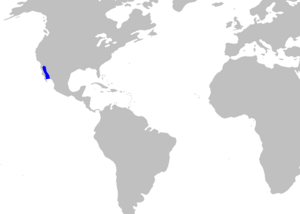Peppered catshark facts for kids
Quick facts for kids Peppered catshark |
|
|---|---|
| Conservation status | |
| Scientific classification | |
| Genus: |
Galeus
|
| Species: |
piperatus
|
 |
|
| Range of the peppered catshark | |
The peppered catshark (Galeus piperatus) is a type of catshark. It lives deep in the ocean, mostly in the northern Gulf of California. This shark is often found near the ocean floor.
Peppered catsharks make seasonal migrations. They spend winter in deeper water. These sharks can grow up to 37 cm (15 in) long. They have a slender, grayish body covered with tiny black dots. A special crest of enlarged scales runs along the top edge of its tail fin.
This shark lays eggs. Its breeding season likely lasts from May to September. The International Union for Conservation of Nature (IUCN) says the peppered catshark is of Least Concern. This means it is not currently threatened by human activities.
Contents
About the Peppered Catshark
The peppered catshark was first described in 1966. Two scientists, Stewart Springer and Mary Wagner, named it. The name piperatus comes from the Latin word piper, meaning "pepper." This refers to the shark's dotted appearance.
The first peppered catshark studied was a female. She was 30 cm (12 in) long. She was found between Tiburón Island and Isla Ángel de la Guarda. This shark is very similar to another group of sharks called Galeus arae from the Atlantic Ocean. Their separation likely happened when the Isthmus of Panama formed about 3 million years ago.
Where It Lives
The peppered catshark lives only in the Gulf of California. Its range goes from the city of Guaymas to Isla Salsipuedes. This shark is quite common in its habitat.
It has been found at depths between 130 and 1,326 m (427 and 4,350 ft). However, it is most often seen at depths of 170–420 m (560–1,380 ft). Even though it usually stays near the bottom, it can swim up to 100 m (330 ft) above the seafloor at night.
In the northern Gulf of California, these sharks seem to disappear in the summer. This suggests they move to deeper, more southerly waters for the winter. This migration is unusual because it's the opposite of what most other fish in the Gulf do. It might be linked to their breeding season in the summer.
What It Looks Like
The longest peppered catshark ever found was 37 cm (15 in) long. This shark has a slender, firm body. Its head is slightly flat, and its snout is long and pointed. The front edges of its nostrils have small, triangular flaps of skin.
Its eyes are oval-shaped and have simple protective eyelids. Behind each eye is a tiny hole called a spiracle. The shark has a large, wide, and curved mouth. There are grooves at the corners of its mouth. Its teeth have a narrow middle point with up to three smaller points on each side. It has five pairs of gill slits.
The shark has two dorsal fins. The first is above its pelvic fins, and the second is above the middle of its anal fin. Both dorsal fins are similar in shape and size. Its pectoral fins are large and wide with rounded edges. The pelvic and anal fins are small and low.
The base of the anal fin is quite long. The tail stalk is flattened from side to side. It leads to a low caudal fin (tail fin). The tail fin has a small lower part and a notch near the tip of the upper part.
The shark's skin is covered in small, overlapping scales called dermal denticles. Each scale looks like a leaf with a ridge and three small teeth. A unique saw-like crest of larger scales runs along the top edge of its tail fin.
The body and tail are dark with many fine black dots. Young sharks might also have darker brown saddle-like markings outlined in white. The edge of the tail fin is white. The inside of its mouth is usually blackish.
Life Cycle and Habits
Scientists don't know much about the daily life of the peppered catshark. They reproduce by laying eggs. This likely happens between May and September. Younger females lay only 2 to 3 eggs at a time. Larger females can lay 10 or more eggs.
Each egg is inside a distinct olive-green capsule. These capsules are about 3.5 cm (1.4 in) long. Interestingly, the egg cases are sometimes eaten by the Pacific angelshark (Squatina california). Baby sharks hatch when they are about 7–8 cm (2.8–3.1 in) long.
Some studies suggest females become mature at 18 cm (7.1 in). Other reports say males mature at 28–29 cm (11–11 in) and females at 26–30 cm (10–12 in).
Conservation Status
The peppered catshark usually lives in waters deeper than where most commercial fishing happens in the Gulf of California. Because of this, it is not often caught by fishing boats.
The International Union for Conservation of Nature (IUCN) has listed the peppered catshark as of Least Concern. This means it is not currently facing major threats to its survival.


